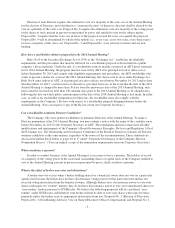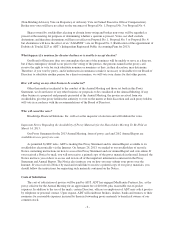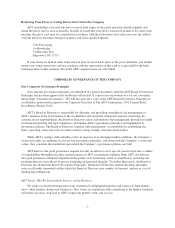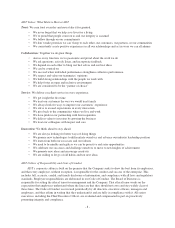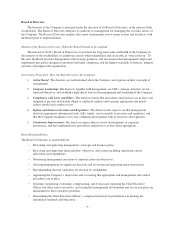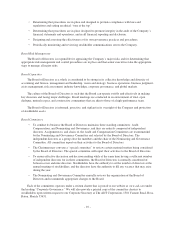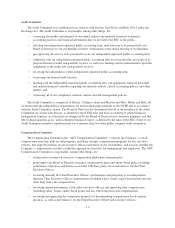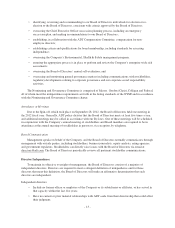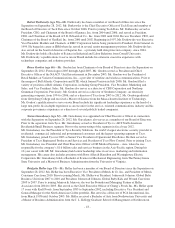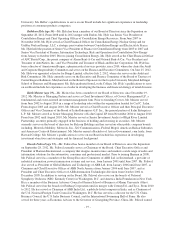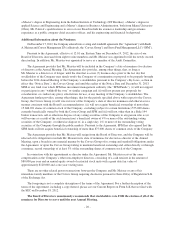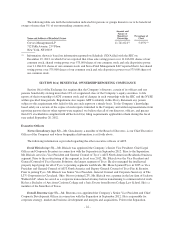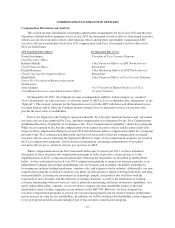ADT 2012 Annual Report Download - page 41
Download and view the complete annual report
Please find page 41 of the 2012 ADT annual report below. You can navigate through the pages in the report by either clicking on the pages listed below, or by using the keyword search tool below to find specific information within the annual report.• A director who is an employee, or whose immediate family member is an executive officer, of a
company that makes payments to, or receives payments from, the Company for property or services in
an amount which, in any single fiscal year, exceeds the greater of $1 million, or 2% of such other
company’s consolidated gross revenues, would not be independent until three years after falling below
such threshold.
Guidelines for Related Party Transactions
The Board of Directors has adopted certain Guidelines for Related Party Transactions. These Guidelines
provide a process for compliance with the related party provisions of the Board Governance Principles, the
Company’s Code of Conduct, and the Company’s Amended and Restated By-laws, as well as the disclosure
obligations of the Exchange Act regulations. The Nominating and Governance Committee will monitor, review
and approve, if necessary, any material related party transactions between ADT and its subsidiaries (collectively,
the “Company”) and its senior officers and directors. ADT’s Guidelines for Related Party Transactions state that
on an annual basis, the Nominating and Governance Committee will receive a list of related parties (the “Related
Party List”) for each senior officer and director and such list will include any entity that employs a director, any
entity (including charitable organizations) for which the director or executive officer serves on the board of
directors, and any entity in which the senior officer or director owns more than a 10% interest. There are three
types of material related party transactions covered by the Guidelines for Related Party Transactions with
specific review procedures:
• Type 1—transactions involving the purchase by or from the Company of products or services in the
ordinary course of business in arms-length transactions.
• Type 2—transactions involving the provision of consulting, legal, accounting or financial advisory
services to the Company that could compromise a director’s independence.
• Type 3—transactions in which a director or officer has a direct or indirect personal interest or that
create a conflict of interest for the director or officer.
Ordinary course of business, arms-length transactions with entities on the Related Party List are deemed
pre-approved by the Nominating and Governance Committee, in amounts in the aggregate for each such entity of
less than 1% of the revenue of such entity or the Company. For Type 1, the Guidelines for Related Party
Transactions provide that the Nominating and Governance Committee, prior to filing the Company’s proxy
statement, annually review the Related Party List, including the amount of payments to or from each related
party, in comparison to the 1% threshold to ensure that the directors meet the director independence requirement.
Any proposed related party transaction involving a member of the Board of Directors must be reviewed and
approved by a majority of the disinterested members of the Board. All related party transactions involving
potential conflicts of interest must be reported to the Nominating and Governance Committee and approved or
ratified by such Committee. During fiscal year 2012, there were no related party transactions that exceeded the
1% threshold.
Director Service
• Directors are elected by an affirmative vote of a majority of the votes cast by stockholders at the annual
meeting and they serve for one-year terms. Any nominee for director who does not receive a majority
of votes cast from the stockholders is not elected to the Board of Directors.
• Directors are not eligible to stand for re-election to the Board of Directors at the annual meeting
following their 72nd birthday. However, the Board of Directors may ask the director to continue service
on the Board when it is deemed to be in the best interest of the Company.
• The Nominating and Governance Committee is responsible for the review of all directors, and where
necessary will take action to remove a director for performance, which requires the unanimous
approval of the Board of Directors. This unanimous approval does not include the approval of the
director whose removal is sought.
-15-


